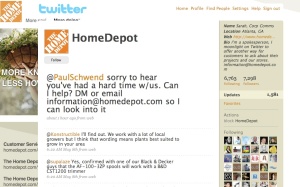by tradesmeninsights | Jun 4, 2009 | Marketing Trends, Social Marketing

When you’re learning blogging 101 and if you have a good instructor, they’ll keep pounding in some basic points to make your blog more effective and ultimately read. It’s nice to see that studies substantiate some of these key findings, and what’s even more surprising are some of the other findings that I never would have thought of. One such study from Eyetrack III, Summary of their tracking new sites, reveals several findings of interest. Here are 7 that caught my eye:
- Your headline must grab attention in 1 second
- Headlines draw eyes before pictures
- People scan the first few words of a headline
- People scan the left side of a list of headlines
- Introductory paragraphs enjoy high readership
- Shorter paragraphs encourage reading
- Smaller type promotes closer reading

by tradesmeninsights | Jun 3, 2009 | Marketing Trends, Social Marketing
 Everyone’s putting out stats on how one element or another of the social media landscape is doing, i.e. 175 million Facebook users spend an average of 3 billion minutes a day on Facebook, according to Conde Nast Portfolio; Twitter is growing at a 1,382% annual growth rate; Facebook has grown from 100 million to 200 million users in less than 8 months.
Everyone’s putting out stats on how one element or another of the social media landscape is doing, i.e. 175 million Facebook users spend an average of 3 billion minutes a day on Facebook, according to Conde Nast Portfolio; Twitter is growing at a 1,382% annual growth rate; Facebook has grown from 100 million to 200 million users in less than 8 months.
What does all this mean to the B-to-B marketer? It means that the world is embracing social media in one form or another. It means that Americans have not only found it, but are using it. Media post reports 49% of us are using some combination of social media in their life. Here’s a breakdown of social usage by age, gender and education that I think you’ll find interesting from a poll by Harris Interactive:
| Online Social Network Usage – By Age & Gender (All Online Adults; % of Age Group) |
|
|
Age Group |
Gender |
| Network Usage |
Total |
18-34 |
35-44 |
45-54 |
55+ |
Male |
Female |
| Have a Facebook or MySpace account |
48%
|
74
|
47
|
41
|
24
|
45
|
52
|
| Update Facebook or MySpace account at least once a day |
16
|
29
|
17
|
10
|
3
|
14
|
18
|
| Use Twitter (Net) |
5
|
8
|
7
|
4
|
1
|
5
|
5
|
| Follow people on Twitter |
5
|
8
|
6
|
4
|
1
|
5
|
5
|
| Use Twitter to send messages |
3
|
4
|
5
|
1
|
*
|
3
|
2
|
| None of these |
51
|
25
|
50
|
59
|
76
|
54
|
47′
|
| Source: Harris Interactive, April 2009 Multiple responses allowed; * indicates less than 0.5% |
| Online Social Network Usage – By Education (All Online Adults; % of Group) |
|
|
Education |
| Network Usage |
Total |
HS or less |
Some College |
College Grad+ |
| Have a Facebook or MySpace account |
48%
|
40
|
55
|
52
|
| Update Facebook or MySpace account at least once a day |
16
|
14
|
18
|
16
|
| Use Twitter (Net) |
5
|
3
|
7
|
6
|
| Follow people on Twitter |
5
|
3
|
6
|
6
|
| Use Twitter to send messages |
3
|
1
|
4
|
4
|
| None of these |
51
|
59
|
43
|
47
|
| Source: Harris Interactive, April 2009 Multiple responses allowed; * indicates less than 0.5% |

by tradesmeninsights | May 27, 2009 | Marketing Trends
 I know you’re convinced that your product or service is the best solution to a tradesman’s problem. According to a recent post in B2B marketing online, a new study from Enquiro Research shows that 99% of B-to-B buying is about CYA. If business buying is driven more by risk adversion, then you need to address those and take the risks out.
I know you’re convinced that your product or service is the best solution to a tradesman’s problem. According to a recent post in B2B marketing online, a new study from Enquiro Research shows that 99% of B-to-B buying is about CYA. If business buying is driven more by risk adversion, then you need to address those and take the risks out.
This puts a different light on how to approach these buyers to improve your conversion rates. Here’s a summary of some of their suggestions:
- Understand Business Buyer Risk. To improve conversion rates, it’s essential to understand the extent to which your company and its products or services may be perceived by your target buyers. From the eyes of the buyers, where do you stack up: are you a major player in the market or a new entry?
- Become an “Approved Vendor.” If you’re not the 800# gorilla in the market, you have an uphill battle. You could have the most brilliant marketing strategy, were able to get in to see the right people and even demo the product, but you don’t get the order. Reason – we got a better deal from our existing vendor or we went with an approved vendor. One way to address this is champion a teaser offer, e.g. 60-day trial period.
- Use Search Marketing to drive Word-of-Mouth. Enquiro research suggests that word-of-mouth can be hugely influential in the buying process, especially in those cases where the buyer has no previous experience in that product category. Search marketing is a powerful tool for getting your message in front of prospects.
- Personalized messages to different targets. Make each landing page, e-newsletter or offer as relevant as possible to the target. To increase conversions: match prospects with happy customers that came from similar risk profiles. Also consider linking to customer reviews.
What are you doing to improve conversions to sales?

by tradesmeninsights | May 18, 2009 | Marketing Trends, Social Marketing
Blogs are now in mainstream media(over 100 million worldwide ) and it presents a unique opportunity for marketers to both influence and monitor conversations that are relevant to your business.
Conversations about you, your brands and your competitors as well are happening as you read this… These conversations are taking place whether you’re participating or not. Wouldn’t you like to be on the inside looking out?
I read a post recently on E marketing Daily that outlined some interesting stats about the number of people either touching or being touched by blogs. Here are some highlights:
Currently, 27.9 million US internet users have a blog they update at least once a month and they represent 14% of the internet population. It’s estimated by 2013 that 37.6 million users will update their blogs at least once a month.

Even more impressive are the number of blog readers. eMarketer estimates that in 2009, 96.6 million US internet users will read a blog. By 2013, 128.2 million people (58% of all US users) will be doing the same.

The numbers tell the story – don’t ignore blogs. They’re not going away and smart B-to-B marketers will get ahead of the curve sooner than later.

by tradesmeninsights | May 13, 2009 | Marketing Trends, Social Marketing
 Micro-blogging is an effective way for people to get messages to the world.
Micro-blogging is an effective way for people to get messages to the world.
Unlike regular blogging where your posts can go on and on and cover numerous subjects, a micro-blog communicates one event. A good comparison is thinking of it as a cross between social networking and blogging. Another way of thinking of it is it’s the new instant messaging vehicle .
If you’re a Facebook user, chances are you’re already micro-blogging to your friends using their status update. Beyond Facebook, there’s Twitter (which is the fastest growing segment of the online market) that allows you up to 140 characters to convey your message (you really have to be good about what you want to say).
Micro-blogs can be used for both personal and business use. For example, if you’re going to a trade show and are introducing a new product, why not do a tweet or a status update on your Facebook page to let people know where and when this event is happening. These can used for product launches, special promotions or new strategic alliances. You must remember that social means conversational (you can’t be putting a hard sell on someone).
Here are examples of Twitter micro-blog posts to @HomeDepot:

Home Depot is using Twitter to offer help and receive feedback.
Do you have any interesting micro-blogs you’d like to share?

by tradesmeninsights | May 11, 2009 | Marketing Tips, Marketing Trends, Social Marketing
 A report by Forrester Research found that most corporate blogs kept by business-to-business (B2B) firms failed to energize their intended audiences and engage them in meaningful conversations about trends and products.
A report by Forrester Research found that most corporate blogs kept by business-to-business (B2B) firms failed to energize their intended audiences and engage them in meaningful conversations about trends and products.
Corporate bloggers are apparently struggling to sustain a conversation, while many B2B marketers are failing to realize that good blogging style should resemble a coffee shop conversation, not a whitepaper.
As a result, most B2B blogs are dull, drab, and don’t stimulate discussion, according to the Forrester report.
More than 70% of the corporate blogs it reviewed stick strictly to business or technical topics and don’t share much personal insight or experience.
74% of B2B blogs receive a minimum of commentary or trackbacks because readers fail to find conversations worthy of their involvement.
Successful blogging, Forrester insists, is not a one-way street, but most corporate bloggers yak away about their companies and products, seemingly oblivious to whether their audience is listening or not.
56% of blogs we examined simply regurgitate company news or executive views, while relatively fewer blogs work to establish thought leadership by enlisting internal experts–with deep, specific knowledge of a particular topic–as their primary blog authors.
“B2B marketers should embrace strategies prominently used by mainstream bloggers to attract readers, build conversations, and engage community members in sharing their experiences with their online peers, the report’s author advises.”
If you can’t get excited about what you do, then please don’t start a blog. It takes time and commitment, and without passion, it’s going to be impossible to move it forward. Your readers will soon spot the lack of passion in what you write.
This isn’t a school project that you do for a set period of time and then it’s done. It’s an ongoing dialog with your audience and it takes planning and managing content and having the right contributors. If you’re organized and have a road map of where you’re going, it will lessen the daily time commitment each of us has. I’ve said in other posts that if you can’t allow 1-2 hours a day to your blog, then don’t do it or find someone who can.
Lee Odden recently gave a presentation, Tips For Better Business Blogging, where he outlines 4 tips for developing a successful blog:
- Develop a practical purpose for your blog
- Plan your editorial and source content
- Socialize by utilizing Facebook, Twitter, Trackbacks to generate traffic
- Measure and promote success to that committee
Conclusion: Social media isn’t going away and businesses will sooner or later figure that out. The key is those that do it first will have a competitive advantage.
Have you had a similar experience you’d like to share?


 Everyone’s putting out stats on how one element or another of the social media landscape is doing, i.e. 175 million Facebook users spend an average of 3 billion minutes a day on Facebook, according to Conde Nast Portfolio; Twitter is growing at a 1,382% annual growth rate; Facebook has grown from 100 million to 200 million users in less than 8 months.
Everyone’s putting out stats on how one element or another of the social media landscape is doing, i.e. 175 million Facebook users spend an average of 3 billion minutes a day on Facebook, according to Conde Nast Portfolio; Twitter is growing at a 1,382% annual growth rate; Facebook has grown from 100 million to 200 million users in less than 8 months. I know you’re convinced that your product or service is the best solution to a tradesman’s problem. According to a recent post in
I know you’re convinced that your product or service is the best solution to a tradesman’s problem. According to a recent post in 

 Micro-blogging is an effective way for people to get messages to the world.
Micro-blogging is an effective way for people to get messages to the world.
 A
A